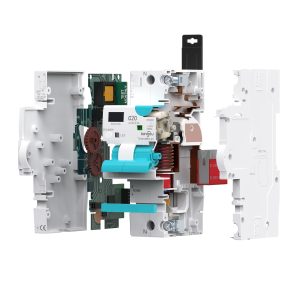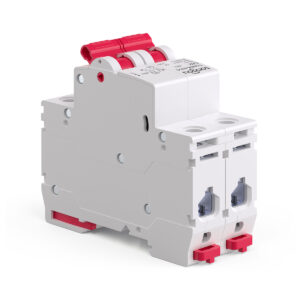
EXHIBITION 2025| TONGOU In China 138th Canton Fair
Booth: Hall 15.2 Booth25-26 Date: October 15-19, 2025
This guide assumes you already know what a breaker is. If you need a primer on basic terms, read our intro pages first. Here we focus on ratings, standards, and real-world selection.
Use MCBs on final circuits with moderate prospective short-circuit current (PSC), typically under the IEC 60898-1 domain.
Use MCCBs for distribution feeders or anywhere PSC is high and you need adjustable protection and higher Icu/Ics (IEC 60947-2).
Select using: ① PSC at installation point (kA) → ② check Icu/Ics margin → ③ verify coordination/selectivity with upstream device → ④ confirm standard fit (60898 vs 60947-2).

Optimized for final circuits (lighting, sockets, small loads). Fixed trip curves (B/C/D), compact footprint, typically lower breaking capacity, governed by IEC 60898-1.
Designed for distribution and higher-demand feeders. Higher short-circuit ratings, adjustable thermal/magnetic settings, accessories (aux contacts, shunt trips), governed by IEC 60947-2.
Rule of thumb: If you are protecting a sub-main or anything with PSC near or above MCB’s rating, evaluate MCCB first.
| Symbol | Name (typical) | What it means in practice |
|---|---|---|
| Icu | Ultimate short-circuit breaking capacity | The maximum fault current the breaker can interrupt once and still provide minimal safety; it may not be fit for service afterwards. |
| Ics | Service short-circuit breaking capacity | The proven breaking capacity at which the breaker can trip and remain serviceable. Often expressed as a % of Icu (e.g., 50%, 75%, 100%). |
| Icm | Making capacity | Peak current the device can make/close onto without damage (relevant for closing on fault). |
| Icw | Short-time withstand | Current the device can carry for a defined short time (e.g., 1s) without tripping—important for selectivity. |
| Inc / Icn | Conditional or rated breaking capacities in specific standards | You’ll see Inc/Icn on some product lines; check the standard definition and test conditions. Do not treat them as identical to Icu/Ics. |
Selection tip: Always verify Ics at the actual PSC—a breaker with high Icu but a low Ics may trip once and need replacement.

IEC 60898-1: For household and similar installations (final circuits). Curves B/C/D, simplified rating presentation.
IEC 60947-2: For industrial/commercial distribution. Detailed Icu/Ics/Icw specs, adjustable trips, coordination tables with upstream devices.
Common mistake: Using 60898-style assumptions (e.g., B/C/D curves only) on a feeder that should be engineered under 60947-2 with proper short-time withstand and selectivity checks.
Measure/estimate PSC (kA) at the breaker’s installation point (consider transformer size, impedance, cable length, and utility fault level).
Choose the standard by circuit function: final circuit → 60898-1 (MCB); distribution/feeder → 60947-2 (MCCB).
Check Icu and Ics ≥ PSC with margin (engineering practice often uses +20–25% headroom).
Verify selectivity/coordination with upstream device using manufacturer tables (time-current curves & energy let-through).
Apply the right trip curve or settings (B/C/D for MCB; adjustable thermal/magnetic for MCCB) based on inrush/start currents.
Document: single-line diagram, ratings, and selectivity proof for inspection/maintenance.
| PSC at Point (kA) | Circuit Type | Typical Device | Standard | Notes |
|---|---|---|---|---|
| ≤ 6 | Final circuits (lighting, small outlets) | MCB (B/C) | 60898-1 | Check curve vs inrush; verify downstream RCD selectivity if used. |
| 6–10 | Final circuits / small sub-boards | MCB (C/D) or small MCCB | 60898-1 / 60947-2 | Consider MCCB if PSC near limit or selectivity needed. |
| 10–25 | Sub-mains / distribution | MCCB | 60947-2 | Adjustable trips, check Ics and Icw for selectivity. |
| ≥ 25 | Main incomer / industrial feeders | MCCB / ACB | 60947-2 | Engineer full selectivity and energy let-through. |
Confusing Icu with Ics (assuming service duty at Icu).
Ignoring selectivity: a downstream trip should not black out the whole facility.
Oversizing current rating to “solve nuisance trips” instead of using the correct curve/setting.
Mixing standards without understanding the test assumptions behind each label.
Q1. Is Ics always 100% of Icu?
No. Many devices have Ics = 50–75% of Icu. Check the datasheet.
Q2. Can I use an MCB on a feeder?
Only if PSC and selectivity requirements are satisfied. In practice, MCCB is preferred for feeders.
Q3. Do B/C/D curves exist on MCCB?
MCCBs typically use adjustable thermal/magnetic settings rather than fixed B/C/D curves.
Q4. What about UL ratings?
UL standards use different terms and tests (e.g., SCCR, interrupting rating). Don’t mix with IEC figures.

Johnson Lim is the General Manager of Changyou Technology and has over 10 years of experience in circuit protection technology and residential electrical safety. He is committed to developing and producing safer and smarter electrical products.

Booth: Hall 15.2 Booth25-26 Date: October 15-19, 2025

RCBO Trips at Night? Causes, Diagnosis, and Lasting Fixes Already know what an RCBO is? Great. This page skips the basics and focuses on nocturnal

MCB B/C/D Curves in Practice: How Inrush Current Shapes Your Choice This guide assumes you already know what an MCB is. If you need a

SPD Coordination for Solar PV and EV Charging: Where to Place Type 1/2/3 Already know the difference between Type 1/2/3 and AC vs DC SPDs?

tongou was established in 1993 and is the trademark of Changyou Technology. We position ourselves as providers of intelligent product solutions for high and low voltage electrical systems, taking on solving customers’ pressures and challenges as our responsibility and creating value for them. We utilize intelligent products to serve global customers, making life smarter and more convenient to benefit your life.
Paidong Industrial Zone Qiligang,Yueqing City,Zhejiang province,China.
Sales: [email protected]
After-sales: [email protected]
© 2025 Changyou Technology. All Rights Reserved.

